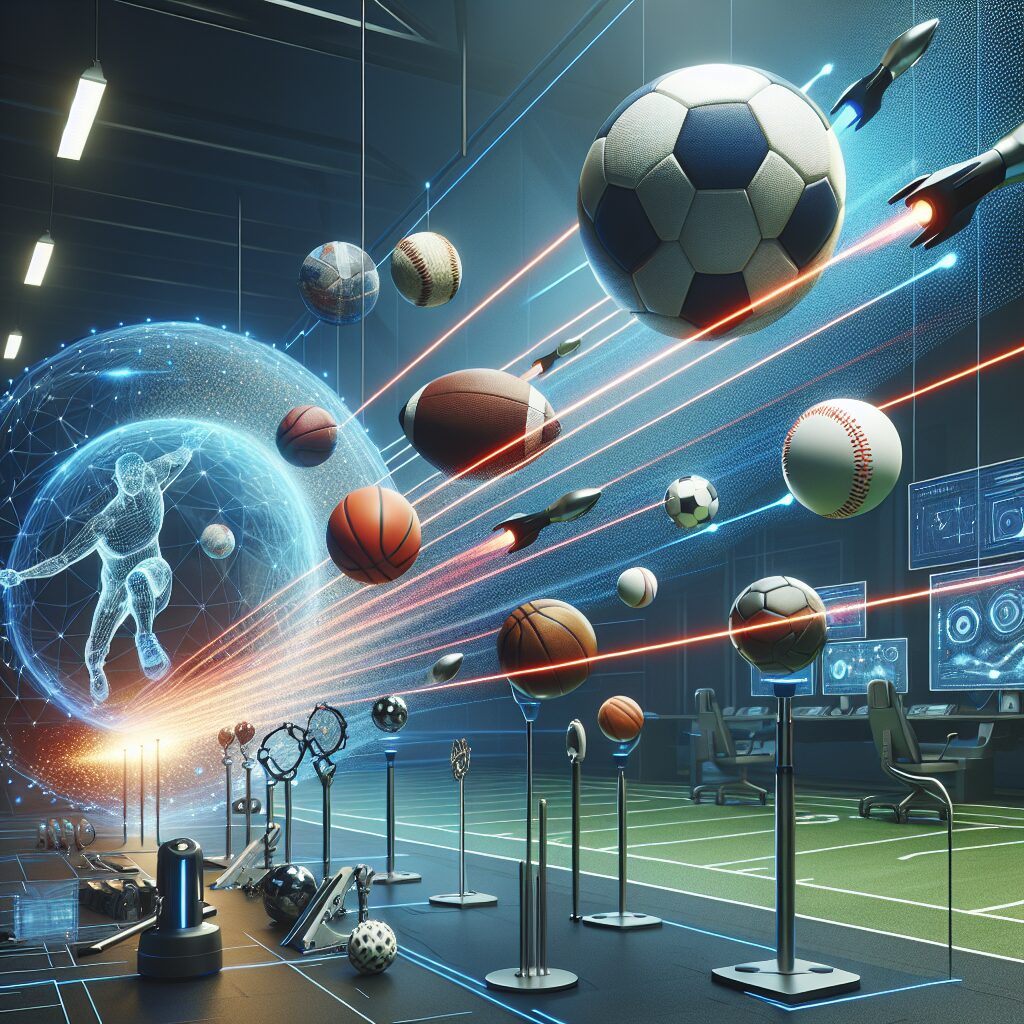Sports Technology and Ball Dynamics: A Symbiotic Relationship
Sports technology has revolutionized the sporting landscape, bringing forth innovative advancements that have forever changed the way athletes train and compete. One such area of focus within this sphere is ball dynamics, which examines the interplay between ball design and the resultant performance on the field. By understanding how various factors influence the behavior of sports balls, athletes and coaches gain invaluable insights that can immensely impact their game.
At the core of ball dynamics lies the recognition that the shape, size, and material composition of a ball can drastically affect its performance. Whether it’s the aerodynamics of a soccer ball, the bounce of a basketball, or the spin of a golf ball, these characteristics play a pivotal role in determining the trajectory and behavior of the ball in play. By studying and harnessing these key features, athletes can adapt their strategies and techniques accordingly, ultimately providing them with a competitive edge.
In the upcoming sections, we will delve into the fascinating world of sports technology and ball dynamics, exploring how these intricacies shape the performance of various sports balls. We will uncover the science behind the capabilities of different ball designs and materials, delving into the impact they have on players’ abilities and strategies. Furthermore, we will discuss the application of these insights in training and how they can contribute to enhanced performance on the field. So, without further ado, let us embark on this illuminating journey and uncover the key takeaways from the symbiotic relationship between sports technology and ball dynamics.
Key Takeaways
1. Sports technology and ball dynamics have a mutually beneficial relationship, where advancements in technology help analyze and improve ball performance, leading to enhanced player performance.
2. The study of ball dynamics involves understanding the aerodynamics, impact forces, and friction that affect a ball’s behavior during play, contributing to the development of innovative sports equipment.
3. The integration of technology, such as high-speed cameras and motion capture systems, allows for precise analysis of ball movements, aiding in the refinement of playing techniques and the design of equipment that delivers optimal performance.
4. In sports like basketball and soccer, advancements in ball technology have led to improvements in areas such as grip, bounce, and accuracy, resulting in a more enjoyable and competitive playing experience for athletes and spectators alike.
5. Collaboration between sports scientists, engineers, and athletes is crucial for maximizing the potential of sports technology and ball dynamics, enabling continuous innovation that pushes the boundaries of athletic performance and game dynamics.
What is the Impact of Sports Technology on Ball Dynamics?
The Evolution of Sports Technology
Sports technology has transformed the way we play and experience various sports. From advanced equipment to data analytics, it has significantly influenced the dynamics of different sports. When it comes to ball sports, the relationship between sports technology and ball dynamics is vital to understand and explore. This section will delve deeper into the evolution of sports technology and its impact on ball dynamics.
The Role of Sports Technology in Enhancing Performance
Sports technology has revolutionized the way athletes and sports enthusiasts interact with the game. It has played a crucial role in enhancing performance levels, and this section will focus on how these advancements have influenced ball dynamics. Topics such as improved ball tracking systems, smart equipment, and intelligent wearables will be discussed, shedding light on the symbiotic relationship between sports technology and ball dynamics.
The Science Behind Ball Dynamics
Ball dynamics is a field where science and technology intertwine. Understanding the physics and mechanics that govern ball motion can provide valuable insights into performance analysis and improvement. This section will explore the fundamental principles of ball dynamics, including trajectory, spin, aerodynamics, and impact physics. Sports technology’s impact on accurately measuring and analyzing these factors will also be examined.
Advancements in Ball Technology
The development of sports technology has led to innovations in ball design and construction. This section will discuss the various advancements in ball technology, such as materials, aerodynamics, and surface textures. It will highlight how these advancements have influenced ball behavior, performance, and ultimately, the dynamics of the game.
Data Analytics and Performance Optimization
In the era of big data, analytics plays a crucial role in sports technology. This section will explore how data analytics tools and technologies have transformed the understanding of ball dynamics. It will delve into topics like player tracking, performance metrics, and predictive modeling, showcasing how these advancements have revolutionized sports performance and strategy.
The Future of Sports Technology and Ball Dynamics
As technology continues to advance at a rapid pace, this section will provide insights into the potential future developments in sports technology and their impact on ball dynamics. From virtual reality training to advanced ball tracking systems, the possibilities are limitless. It will discuss the potential implications of these advancements and how they might reshape the future of ball sports.
Guides and Tips for Optimizing Sports Technology and Ball Dynamics
- Experiment with different sports technology tools and equipment to find the ones that best suit your game and style of play.
- Stay updated with the latest advancements in ball technology to understand how it can enhance your performance and gameplay.
- Invest in wearable devices and smart equipment to track and analyze your ball dynamics, gaining valuable insights into your strengths and areas for improvement.
- Utilize data analytics tools and technologies to measure, track, and optimize your performance based on ball dynamics.
- Explore virtual reality training programs to simulate ball dynamics and improve your reaction time and decision-making skills.
- Collaborate with sports technology experts and coaches to leverage their knowledge and expertise in optimizing ball dynamics.
- Participate in workshops and seminars that focus on the symbiotic relationship between sports technology and ball dynamics to stay at the forefront of advancements in the field.
- Continuously experiment, analyze, and adapt your game based on the insights provided by sports technology, aiming for continuous improvement.
FAQ
1. What is the role of Sports Technology in ball dynamics?
Sports Technology plays a crucial role in understanding and enhancing ball dynamics. It involves the application of scientific principles, data analysis, and advanced technologies to study how balls behave in various sports. By analyzing factors like spin, trajectory, and impact, sports technology helps in improving performance, designing better equipment, and optimizing ball dynamics.
2. How does Sports Technology impact ball design?
Sports Technology has revolutionized ball design by providing insights into factors that influence ball behavior. With technologies like high-speed cameras, motion sensors, and computer simulations, we can analyze the aerodynamics, surface texture, and material properties of balls. This knowledge is then used to optimize ball design, resulting in enhanced performance, improved accuracy, and reduced air resistance.
3. Can Sports Technology improve player performance?
Yes, Sports Technology can significantly improve player performance. By studying ball dynamics, sports scientists and engineers can identify areas for improvement in player technique, equipment, and training methods. For example, understanding how spin affects the trajectory of a ball can lead to better strategies for generating spin in sports like tennis or soccer, ultimately helping players to enhance their skills and performance.
4. Can Sports Technology help prevent injuries in sports?
Absolutely! Sports Technology plays a crucial role in analyzing ball dynamics to minimize the risk of injuries. By understanding the impact forces, energy transfers, and ball-player interactions, researchers can design protective equipment and establish guidelines to prevent common injuries in various sports. Additionally, technologies like impact sensors and biomechanical analysis help in identifying risky movements and improving athlete safety.
5. How does Sports Technology impact the fairness of sports?
Sports Technology aims to ensure fairness by providing a level playing field for all athletes. By understanding ball dynamics, experts can set regulations and standards that govern equipment specifications, dimensions, and performance characteristics. This prevents the use of unfair advantages, such as altering ball properties, and ensures a fair competition where the outcome is determined by skill and strategy rather than technical manipulation.
6. What are some examples of Sports Technology used in ball dynamics research?
Examples of Sports Technology used in ball dynamics research include high-speed cameras, motion capture systems, sensor-embedded balls, computer simulations, and biomechanical analysis tools. These technologies provide valuable data for studying ball behavior, measuring performance parameters, and optimizing equipment design.
7. How does Sports Technology influence ball manufacturing processes?
Sports Technology has greatly influenced ball manufacturing processes. Through advanced testing and analysis, manufacturers can fine-tune material choices, seam configurations, and production techniques to achieve desired ball characteristics. This ensures consistent performance, durability, and reliability in various sports, providing athletes with the best possible playing experience.
8. Is Sports Technology only applicable to professional-level sports?
No, Sports Technology is applicable to sports at all levels, from amateur to professional. While the extent and complexity of technology may differ, the principles can be applied to improve ball dynamics, player performance, and safety in any sport. Even recreational athletes can benefit from advancements in sports technology, as it aids in understanding the game better and enhancing overall enjoyment.
9. How can Sports Technology contribute to the evolution of new sports?
Sports Technology plays a pivotal role in the evolution of new sports by providing insights into ball dynamics and possibilities for innovation. Understanding how different variables influence ball behavior can help in creating unique sports with exciting gameplay and challenging dynamics. Additionally, technology assists in refining rules, equipment specifications, and coaching techniques in emerging sports to ensure fair and engaging competition.
10. Can Sports Technology help in the development of training programs?
Yes, Sports Technology is instrumental in the development of effective training programs. By analyzing ball dynamics, experts can design specialized drills, training equipment, and simulation systems that mimic game situations. This enables athletes to practice specific skills, improve their technique, and optimize their performance by adapting to various ball behaviors encountered in real sports scenarios.
Final Thoughts: Sports Technology and Ball Dynamics
Sports Technology and Ball Dynamics share a symbiotic relationship that has transformed the way we understand and engage with sports. This intersection of scientific analysis, engineering innovation, and sporting excellence has paved the way for unprecedented advancements in equipment design, player performance, and athlete safety.
By constantly exploring the intricate dynamics of balls in sports, technology has propelled the sporting world into new realms of athleticism and excitement. The ongoing research and development contribute to fair competitions, enhanced player capabilities, and the evolution of new sports that capture the imagination of fans across the globe. As technology continues to evolve, we can expect even more fascinating discoveries and innovations in the realm of sports and ball dynamics, revolutionizing the way we play and spectate our favorite games.




